Decentralized finance (DeFi) has revolutionized the way we interact with financial services. Removing the need for intermediaries and offering open access to a wide range of financial instruments has attracted millions of users and billions of dollars in value. However, DeFi has also faced limitations, primarily due to the siloed nature of individual blockchains. This is where cross-chain technology comes in, marking a new era for DeFi with its ability to break down these barriers and unlock its full potential.
Limitations of Regular DeFi
While DeFi has opened up new possibilities for financial inclusion and innovation, it’s not without its drawbacks. The siloed nature of individual blockchains presents several limitations that hinder its true potential. Here are some key constraints of regular DeFi:
- Limited Liquidity
- Each DeFi protocol is restricted to its own blockchain, which creates fragmented liquidity pools. This limits users’ access to the best rates and opportunities, as capital is confined within each chain’s ecosystem.
- Finding optimal liquidity for specific trades or investments becomes challenging due to the lack of a unified pool across different blockchains.
- Smaller DeFi protocols struggle to attract sufficient liquidity, impacting their ability to offer competitive rates and attract users.
- Scalability Issues
- Individual blockchains can experience transaction congestion during periods of high activity, leading to slow transaction times and high fees. This can discourage users and stifle the growth of DeFi applications.
- Ethereum, a popular DeFi platform, often faces scalability issues due to its Proof-of-Work (PoW) consensus mechanism. This limits the number of transactions that can be processed per second, creating bottlenecks and hindering adoption.
- Composability Constraints
- One of DeFi’s strengths is its composability, allowing various protocols to be combined to create innovative financial products. However, this composability is hindered by the lack of interoperability between different blockchains.
- Developers are restricted to working within the confines of a single blockchain’s ecosystem, limiting the potential for creating new and sophisticated DeFi applications.
- Users seeking to combine DeFi protocols across different blockchains face complex workarounds and potential security risks.
- Security Vulnerabilities
- DeFi protocols operate on smart contracts, which are complex pieces of code. Smart contract vulnerabilities can be exploited by hackers, leading to the loss of user funds.
- The open-source nature of DeFi exposes protocols to potential attacks from malicious actors.
- Users lack the same level of protection and recourse mechanisms compared to traditional financial systems.
- Regulatory Uncertainty
- The nascent nature of DeFi creates a lack of clear regulatory frameworks across jurisdictions. This uncertainty can discourage institutional investors and traditional financial players from entering the space.
- Regulatory scrutiny is increasing, posing potential challenges for the future of DeFi and its ability to operate freely.
- Users need to be aware of the potential regulatory risks associated with participating in DeFi activities.
What Is Cross-Chain?
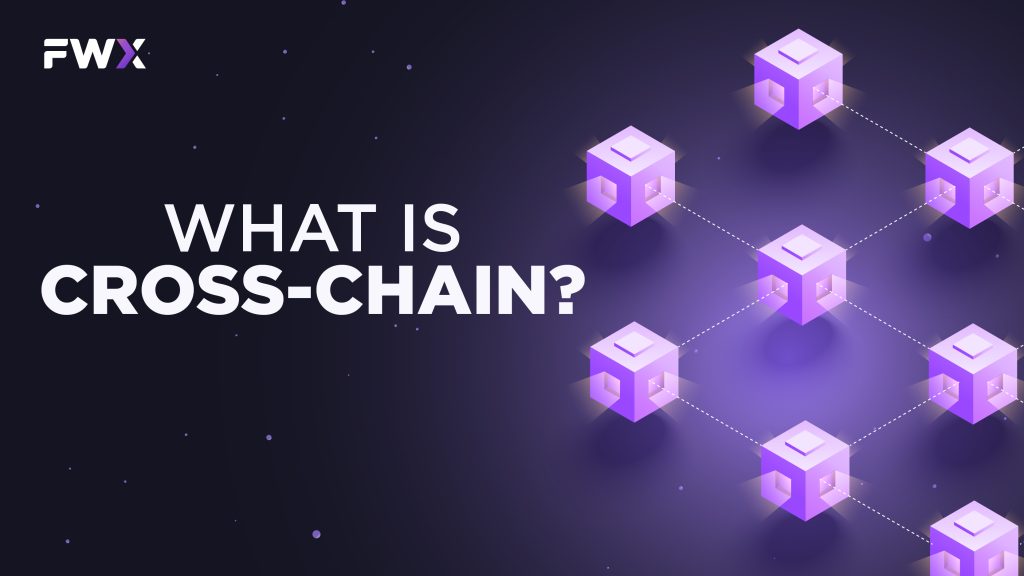
Cross-Chain refers to the capability of different blockchain networks to communicate, share data, and transfer assets seamlessly between each other. It’s a technological advancement that addresses the issue of blockchain interoperability, allowing various blockchains to work together as part of a larger, interconnected ecosystem.
In a traditional blockchain environment, each blockchain operates independently with its own set of rules, consensus mechanisms, and native assets. Cross-Chain technology seeks to break down these barriers, enabling the transfer of digital assets and information across different blockchains. This interconnectedness opens up new possibilities for decentralized applications (dApps), services, and financial instruments.
Why is Cross-Chain Important?
Blockchains are powerful on their own, but their individual nature can be limiting. Each blockchain has its own set of rules, protocols, and communities, creating isolated ecosystems. This can lead to:
- Limited liquidity: Assets are trapped within individual blockchains, restricting access to the best rates and opportunities.
- Scalability issues: Blockchains can become congested, leading to slow transaction times and high fees.
- Fragmented composability: Developers are limited to building DeFi applications within a single blockchain, hindering innovation.
Cross-chain technology solves these problems by breaking down the walls between blockchains. It allows users to:
- Move assets seamlessly between different blockchains: Access better rates and opportunities for DeFi activities like lending, borrowing, and trading.
- Participate in a wider range of DeFi applications: Combine protocols from different blockchains to create more sophisticated financial products.
- Benefit from improved scalability: Utilize the combined capacity of multiple blockchains to handle more transactions more efficiently.
Cross-Chain vs Multi-Chain
Both cross-chain and multi-chain technologies deal with utilizing multiple blockchains, but they have distinct approaches and goals:
Cross-chain
- Focus: Interoperability – enables communication and asset transfer between different, independent blockchains.
- How it works: Utilizes bridges or inter-blockchain communication (IBC) protocols to facilitate interaction between separate chains. Bridges act as intermediary networks, locking assets on one chain and creating corresponding representations on the other. IBC allows direct interaction between chains.
- Benefits: Enables broader market participation by connecting previously isolated ecosystems, unlocks new possibilities for dApps by combining strengths of different chains, increases liquidity and asset utilization.
- Challenges: Security risks due to reliance on bridges or protocols, complexity of implementation, potential for centralization depending on bridge design.
Multi-chain
- Focus: Scalability and flexibility – allows projects to deploy and operate across multiple blockchains simultaneously within a single ecosystem.
- How it works: Leverages shared security infrastructure or parent chains to connect child chains with different functionalities and specializations. Think of it as a network of interconnected blockchains working together.
- Benefits: Improves scalability by distributing workload across multiple chains, enables specialization of chains for specific purposes, simplifies dApp development by providing a unified platform for cross-chain interaction.
- Challenges: Requires robust shared security infrastructure, potential for cascading failures across the ecosystem, complexity of managing multiple chains.
In summary
- Cross-chain: Connecting independent blockchains like islands via bridges.
- Multi-chain: A unified blockchain ecosystem with specialized sub-chains.
Choosing between cross-chain and multi-chain depends on your specific needs and goals. Cross-chain is ideal for interacting with existing, established blockchains, while multi-chain offers better scalability and flexibility within a closed ecosystem.
What Is a Cross-Chain Bridge?
A Cross-Chain Bridge is a technological infrastructure or protocol designed to facilitate the seamless and secure transfer of assets and data between different blockchain networks. Its primary function is to act as a connector, enabling interoperability among disparate blockchains. Cross-Chain Bridges play a crucial role in realizing the vision of a more interconnected and versatile blockchain ecosystem.
Types of Cross-Chain Bridges
Cross-chain bridges are fascinating tools in the world of blockchain, enabling the movement of assets between different blockchains. But with so many options available, understanding the different types can be overwhelming. Don’t worry, I’m here to help! Here are some of the most common types of cross-chain bridges:
1. Burn and Mint Bridges
- These bridges operate by “burning” your tokens on the source chain, essentially taking them out of circulation.
- In exchange, the same amount of native tokens are “minted” on the destination chain.
- This approach ensures a 1:1 ratio between chains, but can be slower and costly due to transaction fees on both chains.
2. Lock and Unlock Bridges
- Instead of burning and minting, these bridges “lock” your tokens in a smart contract on the source chain.
- On the destination chain, a corresponding amount of tokens are “unlocked” from a liquidity pool.
- This method is often faster and cheaper than burn-and-mint bridges, but requires maintaining liquidity pools and can introduce additional risks.
3. Federated Bridges
- These bridges rely on a group of trusted validators to verify and approve cross-chain transactions.
- The validators can be centralized or decentralized, depending on the bridge design.
- Federated bridges offer faster transaction times than some other types, but raise concerns about centralization and potential for manipulation.
4. Sidechain Bridges
- Sidechains are separate blockchains connected to the main chain via a two-way peg.
- Assets can be transferred between the main chain and the sidechain using the peg.
- Sidechain bridges can offer faster and cheaper transactions than bridges between completely separate chains.
5. Wrapped Token Bridges
- These bridges create “wrapped” tokens that represent assets from other chains.
- For example, wrapped Bitcoin (WBTC) is an Ethereum token that represents Bitcoin held on the Bitcoin blockchain.
- Wrapped tokens allow you to use assets from other chains within DeFi and other applications on the target chain.
Choosing the Right Bridge:
- The best type of bridge for you depends on your specific needs and priorities. Consider factors like:
- Supported blockchains: Does the bridge connect the chains you need?
- Transaction speed and fees: How fast are transactions and how much do they cost?
- Security: What are the security risks involved in using the bridge?
- Decentralization: How decentralized is the bridge?
How Does Cross-Chain DeFi Work?
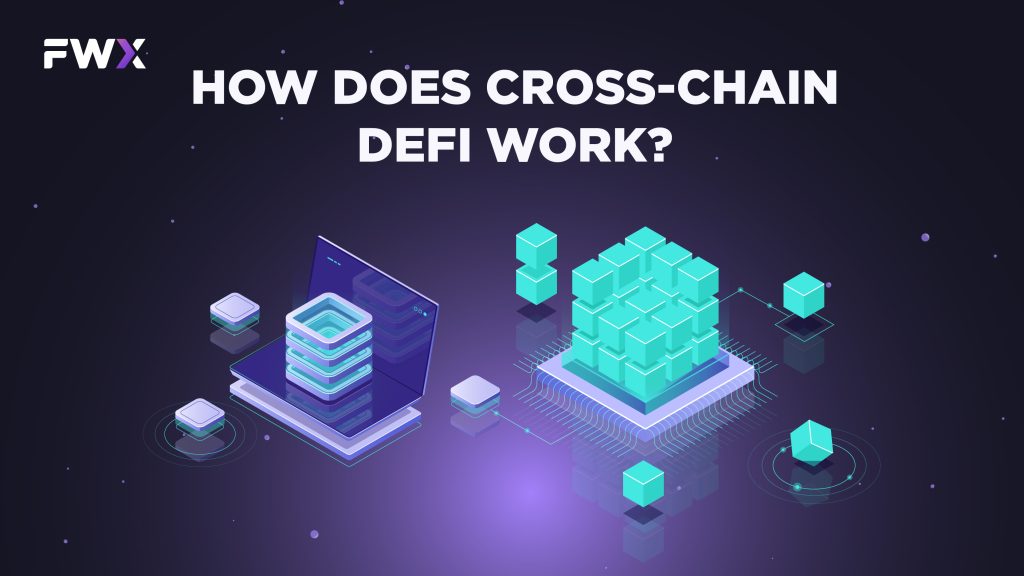
Cross-chain DeFi opens up exciting possibilities by connecting the financial applications of different blockchains, but understanding how it works can be a bit intricate. Let’s break it down into key components:
1. Interoperability Protocols
- These are the “bridges” that enable communication and data exchange between disparate blockchains. They come in various types, as you mentioned earlier, each with its own security and speed trade-offs. Popular examples include Ren, AnySwap, and Stargate.
2. Bridge Infrastructure
- This involves smart contracts on both sides of the bridge. The source chain contract locks your tokens while the destination chain contract unlocks a corresponding amount (depending on the bridge type). This ensures the integrity and value of your assets during the transfer.
3. Asset Locking and Unlocking
- As mentioned above, when initiating a cross-chain DeFi transaction, your chosen bridge typically locks your tokens in a smart contract on the source chain. This creates a representation or replica of your assets on the destination chain, which you can then use in DeFi protocols there. Upon returning your funds, the destination chain token is burned, and your original tokens are unlocked on the source chain.
4. Cross-Chain Communication
- To seamlessly integrate DeFi protocols across chains, bridges facilitate communication between smart contracts. This can involve oracle networks that provide reliable data feeds or specialized protocols that relay transaction information.
5. DeFi Applications
- The real magic happens when you can utilize your transferred assets in DeFi protocols on the destination chain. This opens up a vast array of possibilities, like:
- Yield farming: Earn higher returns by depositing your assets in liquidity pools across multiple chains.
- Borrowing and lending: Access lending and borrowing opportunities with potentially better interest rates on different platforms.
- Margin trading: Increase your leverage and trade derivatives across various DeFi ecosystems.
- Decentralized exchange (DEX) trading: Swap tokens and access new liquidity pools on different DEX platforms.
Cross-chain DeFi vs Regular DeFi
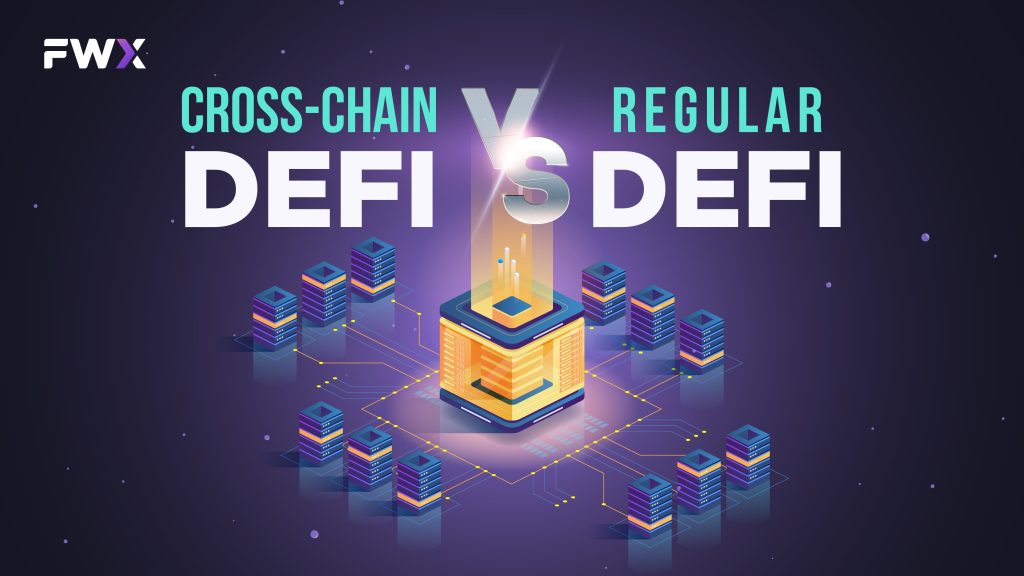
Choosing between Cross-chain DeFi and Regular DeFi depends on your specific needs and priorities. Both offer unique advantages and drawbacks, so understanding the key differences can guide your decision.
Regular DeFi
Pros:
- Simple and familiar: Operates within a single blockchain network, making it easier to understand and use, especially for beginners.
- Established and secure: Many DeFi protocols have been around for years, offering proven track records and robust security measures.
- Potentially lower fees: Transactions may be cheaper as they stay within a single network.
Cons:
- Limited liquidity: Restricted to the assets and protocols available on that specific blockchain.
- Potentially higher gas fees: Some congested chains like Ethereum can incur high transaction fees.
- Limited diversification: Exposure is confined to the chosen blockchain ecosystem.
Cross-chain DeFi
Pros:
- Increased liquidity: Access a wider pool of assets and DeFi protocols across multiple blockchains, leading to better opportunities and deeper markets.
- Improved asset utilization: Leverage your assets across different DeFi platforms for potentially higher returns and more diverse strategies.
- Access to unique opportunities: Unlock DeFi applications and assets previously restricted to specific chains, expanding your investment options.
- Greater diversification: Spread risk across different blockchain ecosystems for a more balanced portfolio.
Cons:
- Security risks: Bridge hacks and vulnerabilities can lead to significant losses of funds.
- Complexity: Understanding different bridge types and DeFi protocols across various chains can be challenging.
- Interoperability limitations: Not all blockchains and DeFi applications are equally compatible, hindering seamless integration.
- Potentially higher fees: Cross-chain transactions may incur additional fees compared to single-chain interactions.
Types of Cross-Chain DeFi
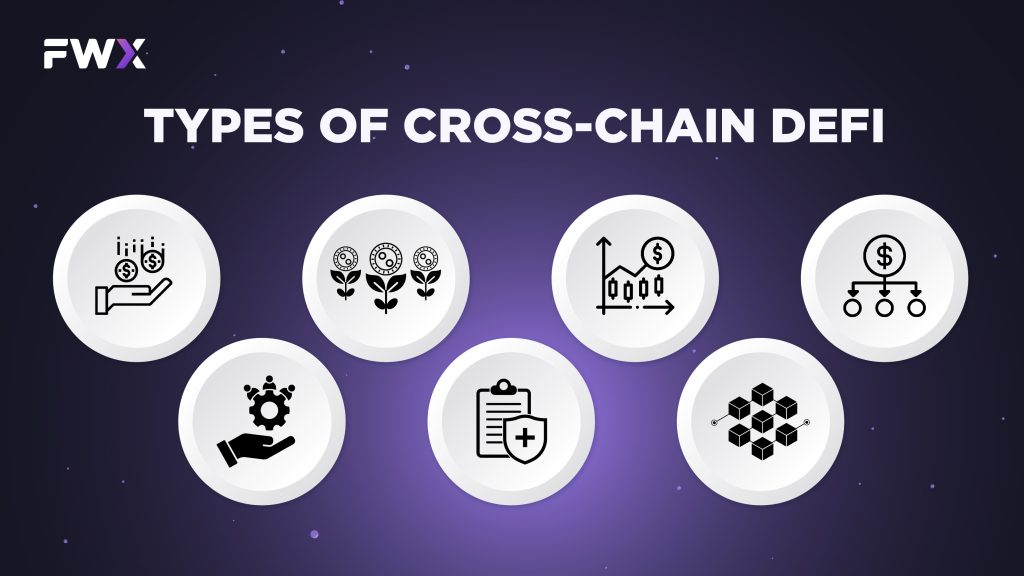
Cross-chain DeFi is an exciting landscape, offering various applications and possibilities. To further delve into its intricacies, let’s explore different types based on their functionality:
1. Cross-Chain Lending and Borrowing
- This type enables users to utilize their assets as collateral across multiple chains, unlocking access to better interest rates and lending opportunities.
- Examples: Aave, Compound, Venus Protocol (with cross-chain bridges).
2. Cross-Chain Yield Farming
- Users can deposit their assets in liquidity pools across different chains to maximize their returns by leveraging higher liquidity and potentially better yields.
- Examples: Curve, Balancer, Uniswap (with cross-chain bridge integrations).
3. Cross-Chain Margin Trading
- This allows users to increase their leverage and trade derivatives by borrowing assets from one chain and using them on another for amplified gains (or losses).
- Examples: dYdX, Perpetual Protocol, GMX (with cross-chain bridges).
4. Cross-Chain Derivatives
- Users can access and trade derivatives like options and futures contracts on different chains, diversifying their portfolios and hedging risks.
- Examples: Synthetix, UMA, Opyn (with cross-chain bridge support).
5. Cross-Chain Asset Management
- This emerging area enables users to invest in professionally managed DeFi portfolios that automatically rebalance and optimize across various chains.
- Examples: Yearn Finance, Gauntlet Network, PieDAO (with cross-chain integrations).
6. Cross-Chain Insurance
- Users can protect their DeFi investments against smart contract bugs, hacks, and other risks by purchasing insurance coverage across different chains.
- Examples: Nexus Mutual, Unslashed Finance, Cover Protocol (with cross-chain bridge compatibility).
7. Decentralized Exchanges (DEX) Aggregation
- These platforms aggregate liquidity from DeFi exchanges across multiple chains, allowing users to find the best exchange rates and execute trades with optimal price discovery.
- Examples: 1inch, Matcha, KyberSwap (with cross-chain liquidity sourcing).
Benefits of Cross-Chain DeFi
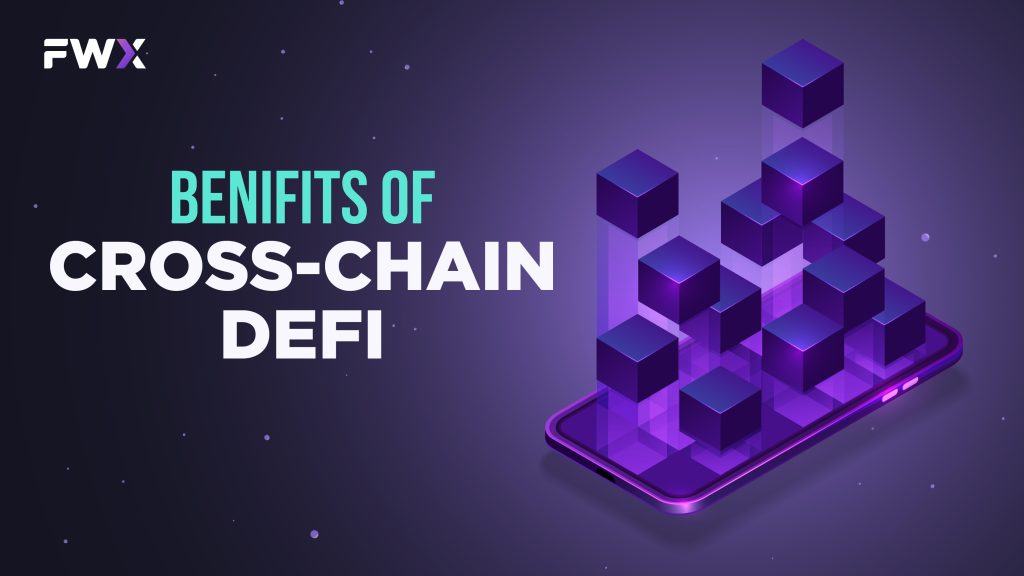
The benefits of Cross-chain DeFi are numerous and far-reaching, opening up a world of financial possibilities that transcend the limitations of individual blockchains. Here’s a deeper dive into some of the key advantages:
1. Increased Liquidity
- Aggregates liquidity from multiple chains, creating deeper markets and better opportunities for users. This leads to tighter spreads, higher effective yields, and more efficient price discovery.
2. Improved Asset Utilization
- Enables users to leverage their assets across different DeFi protocols on various chains, maximizing their potential returns and optimizing their investment strategies. Users can earn yield on multiple chains simultaneously, diversifying their income streams.
3. Access to Unique Opportunities
- Unlocks DeFi applications and assets previously restricted to specific chains, expanding investment options and introducing users to novel financial instruments. This empowers users to explore innovative DeFi protocols and strategies not available on their native chain.
4. Greater Diversification
- Spreads risk across different blockchain ecosystems, protecting users from the volatility and potential failures of any single chain. This allows for a more balanced portfolio and mitigates the impact of localized market movements.
5. Enhanced Efficiency and Convenience
- Streamlines DeFi interactions by enabling users to manage their assets and investments across multiple chains from a single interface. This eliminates the need to switch between different platforms and simplifies portfolio management.
6. Increased Innovation and Competition
- Fosters a more vibrant and competitive DeFi landscape by connecting multiple blockchain ecosystems. This encourages the development of new protocols, applications, and strategies as developers vie for user attention and capital.
7. Accelerated Decentralization
- Strengthens the overall decentralized finance ecosystem by promoting interoperability and breaking down the walls between isolated blockchains. This strengthens the network effect and contributes to the long-term growth and resilience of DeFi.
8. Potential for Lower Fees
- While cross-chain transactions may incur additional fees compared to single-chain interactions, accessing lower fees on other chains can be strategically beneficial. Depending on market conditions and protocol choices, users may find better fee options by utilizing cross-chain solutions.
Risks of Cross-Chain DeFi
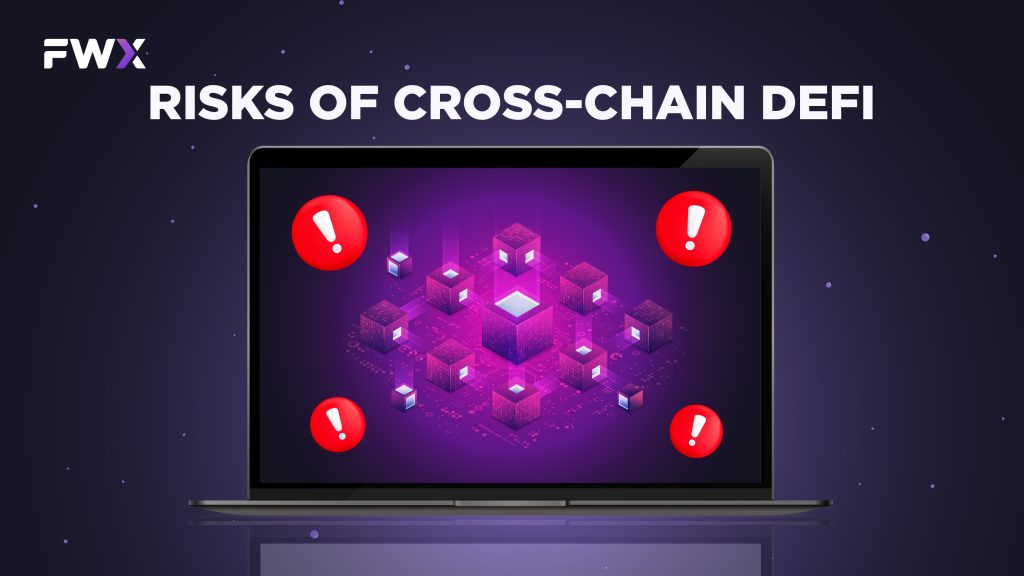
While Cross-chain DeFi unlocks exciting opportunities, it also presents significant risks. Understanding these potential pitfalls is crucial before venturing into this dynamic landscape. Here are some key concerns to be aware of:
1. Security Risks
- Bridge Hacks: Cross-chain bridges act as potential entry points for hackers. Exploiting vulnerabilities in these bridges can lead to the theft of user funds locked in transit. High-profile bridge hacks like the Ronin Bridge attack (March 2022) illustrate the severity of this risk.
- Smart Contract Bugs: DeFi protocols themselves are susceptible to smart contract vulnerabilities, which can be exploited to drain user funds or manipulate the protocol’s behavior. Cross-chain interactions add complexity, potentially amplifying the impact of such vulnerabilities.
- Rug Pulls and Scams: Malicious actors may create fake DeFi protocols or bridges specifically targeting cross-chain users. Thorough research and due diligence are essential to avoid falling victim to scams.
2. Complexity and User Error
- Interoperability Challenges: Not all blockchains and DeFi protocols are equally compatible. Understanding the different bridge types, their technical limitations, and potential interoperability issues can be challenging for new users.
- User Error: Performing cross-chain transactions involves additional steps and complexities compared to single-chain interactions. Mistakes like sending funds to the wrong address or choosing an incompatible bridge can lead to permanent loss of funds.
- Loss of Control: When using centralized bridges or relying on specific bridge operators, users may face limitations in controlling their funds and managing their transactions.
3. Regulatory and Legal Uncertainty
- Unclear Regulations: The legal landscape surrounding DeFi and cross-chain transactions is still evolving. Regulatory uncertainty can pose challenges for users and developers, potentially impacting the long-term viability of certain protocols or bridges.
- Tax Implications: Cross-chain transactions may involve complex tax implications depending on jurisdiction and user circumstances. Consulting with a qualified tax advisor is crucial to ensure compliance and avoid potential penalties.
4. Market Volatility and Price Manipulation
- Liquidity Risk: Cross-chain liquidity can be fragmented, leading to higher price volatility and slippage when executing large transactions. This can amplify losses in volatile market conditions.
- Price Manipulation: Malicious actors may exploit the interconnectedness of cross-chain DeFi ecosystems to manipulate prices across different chains or markets.
5. Environmental Concerns
- Energy Consumption: Some cross-chain solutions, particularly those relying on proof-of-work consensus mechanisms, can have a significant environmental impact due to their high energy consumption. Users should be aware of the environmental implications of their cross-chain activities.
What Is Cross-Chain Crime?
Cross-chain crime refers to the illicit activities that leverage the interconnectedness of multiple blockchains to obfuscate the origin and movement of stolen or illegally obtained funds. Imagine a labyrinth of financial alleyways, each one a separate blockchain, where criminals can hop from one chain to another, making it harder for authorities to track their tracks.
Types of Cross-Chain Crime
- Money laundering: Criminals use cross-chain transactions to “wash” dirty money from illegal activities like drug trafficking, ransomware attacks, or stolen funds.
- Sanctions evasion: Individuals or entities under sanctions can use cross-chain swaps to bypass restrictions on their financial transactions.
- Market manipulation: Malicious actors can exploit the interconnectedness of different blockchain markets to manipulate prices and execute pump-and-dump schemes across multiple chains.
- Tax evasion: Criminals may utilize cross-chain transactions to obfuscate their income and avoid paying taxes.
- Cybercrime: Hackers and scammers may use cross-chain bridges or DeFi protocols as entry points for attacks, stealing user funds or manipulating the system for their own gain.
Real-World Example
In 2022, the Ronin Bridge, a platform connecting the Axie Infinity game to the Ethereum blockchain, was hacked for over $600 million worth of crypto. The attackers used stolen funds to jump across various blockchains like Ethereum, Bitcoin, and Binance Smart Chain, making it challenging to track their movement. They then employed various laundering techniques to ultimately cash out some of the stolen funds. This is a prime example of how cross-chain crime can occur in the real world, highlighting the sophistication and complexity of cybercriminals operating in the crypto space.
Conclusion
Cross-chain technology is not merely a technical innovation; it represents a paradigm shift in the world of DeFi. It’s a resolute rejection of fragmentation and a bold vision for a future where financial freedom transcends the boundaries of individual blockchains. As bridges continue to evolve and user experiences improve, the DeFi landscape will transform into a boundless archipelago, teeming with innovation and opportunity. This shift promises to redefine financial systems and empower users like never before. The future of DeFi lies not in isolated chains, but in the interoperable utopia woven by cross-chain technology.


